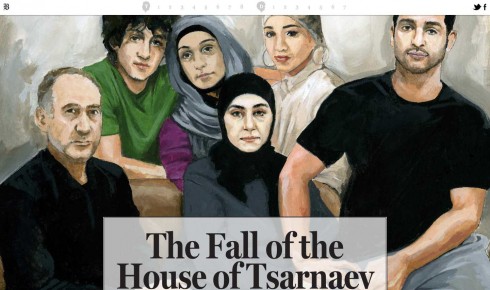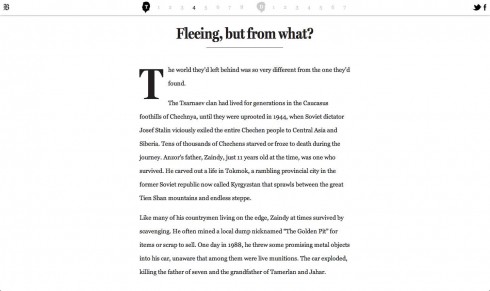TAKEAWAY: Snowfall is more than a verb or a spectacularly presented story which pioneered in new ways of storytelling: it has also become one of the most current debate subjects in the industry.


Screen shots from The Boston Globe’s The fall of the house of Tsarnaev (image from storify.com)

How the story appeared in The Boston Globe’s print edition
And to prove that, Storify carried a piece complete with all the Twitter dialogs that be quite engaging, as people tweeted their opinions with pros and cons of ‘Snowfalling’ stories.
The tweets are part of a conversation on Twitter (Dec. 15, 2013) about use of the technique often called parallax scrolling, which first became popular when The New York Times published a story titled Snow Fall.
In this case, the Snowfall-like story in question was The fall of the house of Tsarnaev – published by The Boston Globe and based on a five-month Globe investigation offering new details and insights into the two young men accused in the Boston Marathon terrorist attack.
So in the Storify piece, actual screen shots of tweets are shown, allowing us to see how the dialog went. Don’t miss it, as it makes for some interesting and timely reading,with both sides of the Snowfall debate coming to life in a powerful way.
Here are some examples:
…. immersive multimedia formats enhance great text journalism with superb visuals that are themselves journalism!
No. these are family pictures and cartoons with bizarre spacing on text. It is the enemy of real journalism.
God, just let the journalism speak for itself. Dismantle all your Snowfall wannabe teams
From here, journalism doesn’t look to be suffering from an overabundance of digital skill/thinking
When you have a Snowfall hammer, everything looks like a nail.
It’s about using the technology where it works. The Snowfall “innovation” has overtaken all others. A parasite on resources.
My take
While I did not participate directly in the tweet exchange, and was not even aware that this story had been published, the Storify piece made me curious about the Boston Globe treatment of the story.
I confess that I was selective in the segments I chose to read, but the way the story was segmented allowed me to navigate through it effortlessly. I think that there are elements of Tomato Can Blues (another New York Times multimedia story), including the “boxing” element that is crucial to this piece. I found the white space to be helpful in guiding us through all that scrolling; liked the use of typography and the overall look and feel of the piece. I was not able to watch any of the videos when I accessed the piece, but I am glad they were included and I am sure they added to the texture and storytelling.
At the end, however, either one is predisposed to read this type of stories or not -the same applies to print, however. In my view, multimedia storytelling is still in its infancy. I applaud the Globe and any other newspaper team that decides to tackle a story this way.
This story, whether in multimedia or in its printed version, has substance, depth and is written in such a way that it engages
And, a clincher: at least one of those engaged in the Twitter debate asked to clarify what Snowfall was!
Which means that snowfalling has a long way to go before it becomes a household item, or before we find a formula to tell this type of stories in a way that will please a majority.
See the Boston Globe piece here:
http://www.bostonglobe.com/Page/Boston/2011-2020/WebGraphics/Metro/BostonGlobe.com/2013/12/15tsarnaev/tsarnaev.html
For related material:
https://medium.com/p/f6173da5ca19